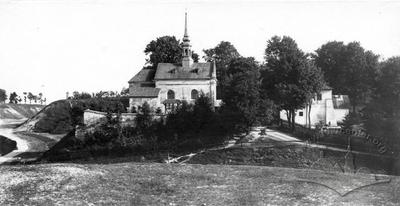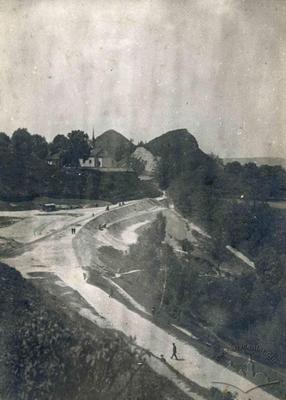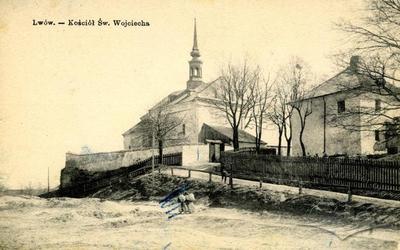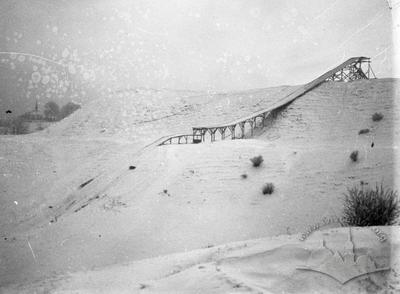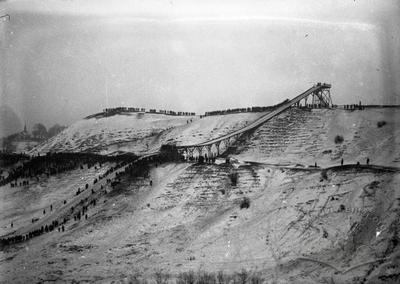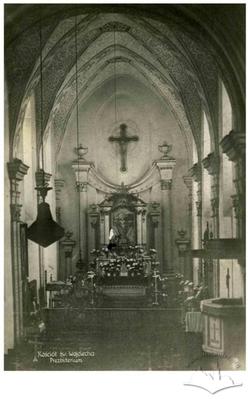Vul. Dovbusha, 24 – former st. Wojciech church
The St. Wojciech church was built by one of the best Lviv constructors, Paolo Romanus, and belongs to the last examples of the Renaissance style in Lviv. According to the resolution of the Regional Executive Committee of the Lviv Region number 393 dated 22 November 1988, the house was entered into the Register of local monuments under protection number 903-M.
On 8 September 1996, after a restoration, the church was consecrated in the name of St. Josaphat and All Ukrainian Martyrs; the members of the Milites Christi Imperatoris congregation have settled in the renovated premises of the monastery.
Architecture
From each side the complex is enclosed with a wall which reinforces the slopes from the east, north and west due to the complicated local topography. Apart from the church, a small territory is occupied by a two-storied monastery building and a small utility one. Behind the wall, a part of the southern slope of the Zmiyeva mount belongs to the monastery too; it is enclosed with a metal net fence.
The church is a small one-nave building with a narrow faceted chancel and a sacristy located at its northern wall. Thick and ascetic walls with high-placed semicircular windows, as well as stairs, arranged in the back wall which lead to the choir gallery and to the roof, indicate the defensive character of the building. The main façade is emphasized by Tuscany order pilasters on its corners and is topped by a triangular gable decorated with shallow semicircular niches. A Baroque flèche rises over the double-pitched roof; it must have been constructed in the course of a repair. Two sacristy windows are decorated with a Renaissance framework.
The layout of the church is typical for its time. The church's nave is divided into two bays covered with ribbed vaults, a stellar vault covers the chancel. Also, a ribbed vault covers the sacristy. In the interior, the church walls are covered with a modern-style murals depicting some thematic compositions, in particular, St. Josaphat and all Ukrainian martyrs in whose name the church is consecrated.
Personalities
Bartołomeusz
Zimorowicz – a Lviv chronicler who wrote a book entitled Leopolis triplex.
Dyoniziusz Zubrzycki – a Lviv historian
(19th c.).
Karl XII – a Swedish king.
Mila Mina – a Czech painter who
made murals in the church.
Paolo Romanus – a Lviv architect
(turn of the 17th c.).
Petro Moskalyk – the founder of a
plague cemetery on the top of the Leva mount.
Steve – an Irish monk who
founded the Ukrainian branch of the Milites Christi Imperatoris congregation.
Tommy – an Irish monk who
founded the Ukrainian branch of the Milites Christi Imperatoris congregation.
Sources
1. Central State Historical Archive of Ukraine in Lviv (CDIAL). Item 146/20/70
2. CDIAL. Item 186/8/633
3. CDIAL. Item 726/1/1739
4. Tadeusz Mańkowski Lwowskie kościoły
barokowe. (Lwów, 1932).
5. Czesław Thulie O kościołach lwowskich z
czasów odrodzenia. (Lwów, 1913, 55).
6. Łucja Charewiczowa . Historiografia i
miłośnictwo Lwowa. Biblioteka lwowska. T. VI. (Warszawa, 1990), 228-232.
7. Adam Krajewski, Lwowskie przedmieścia,
Biblioteka lwowska, T. I (Warszawa, 1990), 37-38.
8. Olgierd Czerner, Lwów na dawnej rycinie i
planie (Wrocław-Warszawa-Kraków, 1997).
9. Jan Sas Zubrzycki, Zabytki miasta
Lwowa (Lwów, 1928), 52-53.
10. Іван
Крип’якевич, Історичні проходи по Львові
(Львів, 1991), 91-92.
11. Денис
Зубрицький, Хроніка міста Львова (Львів, 2002), 215.
12. Бартоломій
Зіморович, Потрійний Львів (Львів, 2002), 140-141.
13. Мар’яна
Долинська, Львів: простір і мешканці. Історико-урбаністичний
нарис (Львів, 2005).
Material compiled by
Oksana Boyko and Vasyl Slobodyan
Media Archive Materials
Related Pictures














